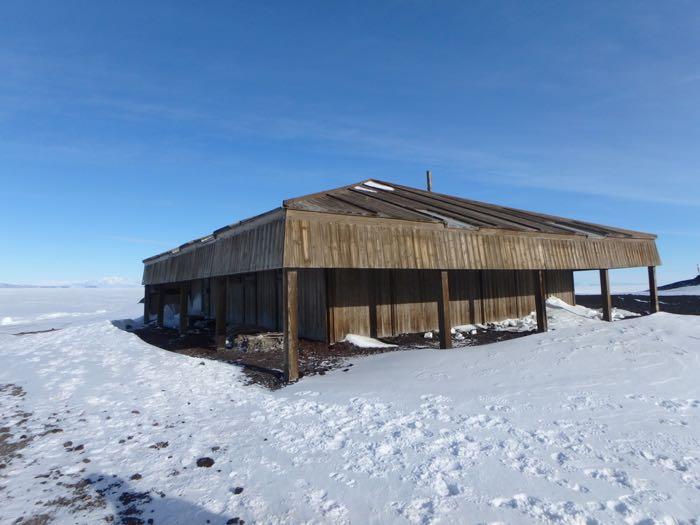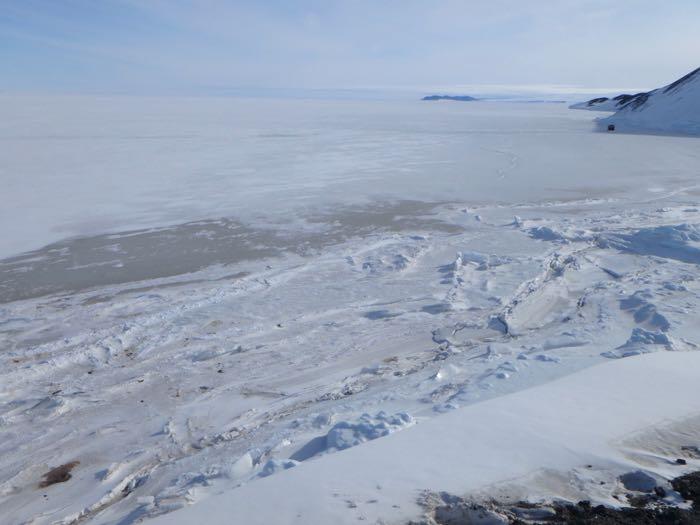"Ice, Ice Baby" -Vanilla Ice
Have you ever looked at a map or globe of the world and noticed Antarctica? If you have a map or a globe, grab one now and take a look at it or type it into google maps. It's almost always white! Why? Because most of it is covered in ice!
Now, think about what you know about ice? How is it made? What does it feel like? One of the many things I've loved learning about so far throughout my PolarTREC journey is ice. I am fascinated by all of the different types of ice, how it changes over time, and how all of this ice in the polar regions impacts the rest of us on earth. Did you know that even if you are sitting on your porch in Ohio, surfing in California, or wandering through the streets of Spain that YOU are affected by the ice in Antarctica?
 The destination of my walk today. Amy Osborne near Scott's Discovery hut standing in front of sea ice.
The destination of my walk today. Amy Osborne near Scott's Discovery hut standing in front of sea ice.
While the research team was off diving I was supposed to have my sea ice training, which was cancelled and rescheduled for tomorrow. So, instead I wandered out of McMurdo town and towards Scott's Discovery Hut, which is on a peninsula across from McMurdo Station. It was a nice warm sunny day, the windchill was only -22°C/-7°F versus yesterday's windchill of -33°C/-29°F. My walk on this beautiful day gave me a chance to see the sea ice a bit more closely. As my feet squeaked and crunched across the lightly snow covered ground I wondered, what's up with all of this ice?
 Located on Ross Island near McMurdo Station, this is the hut that was built for Robert Scott's Discovery expedition 1901-1904,a British expedition to conduct scientific research and geographical exploration. The hut was built in 1902.
Located on Ross Island near McMurdo Station, this is the hut that was built for Robert Scott's Discovery expedition 1901-1904,a British expedition to conduct scientific research and geographical exploration. The hut was built in 1902.
I've learned there are two major categories of ice: land ice and sea ice. The Arctic, which is the northern polar region, is ocean and sea ice surrounded by land. Antarctica, in the southern polar region, is a continent covered in ice (land ice) that is surrounded by the sea, which also can be covered in ice (sea ice). Because I'm, eventually, headed out to the sea ice to support the folks who are diving under it and studying the animals that live down there, let's learn some more about sea ice.
 This shows the icy continent of Antarctica surrounded by sea ice and the ocean of the Arctic in ice. Credit: NASA's Goddard Space Flight Center
This shows the icy continent of Antarctica surrounded by sea ice and the ocean of the Arctic in ice. Credit: NASA's Goddard Space Flight Center
SEA ICE
15% of the world's oceans are covered in sea ice at certain times of the year! Total sea ice in the polar regions covers 25 million square kilometers (9,652,553 square miles) of the earth, which is about 2 and half United States put together. That is a lot of sea ice at either end of this big ball of earth we call home!
Sea ice grows in the winter months. In Antarctica, that means it grows in June, July, and August. Sea ice melts in summer months. Antarctica generally reaches its maximum amount of sea ice in mid-September and its minimum in mid-February. Some sea ice remains all year round. Antarctica's sea ice can fluctuate by 6 million square miles between the summer and the winter!
 This shows what Antarctica sea ice looks like in September when it's at its maximum and what it looks like in February when it's at its minimum. Image credit: NOAA Climate.gov NSIDC
This shows what Antarctica sea ice looks like in September when it's at its maximum and what it looks like in February when it's at its minimum. Image credit: NOAA Climate.gov NSIDC
What is sea ice?
The simple definition is sea ice is frozen ocean.
Unlike freshwater, which freezes at 0°C/32°F, salt water has a lower freezing point and won't freeze until -1.8°C/28°F. If you are in a place where you have access to both salt water and fresh water and a freezer where you can keep track of the temperature, you could try some ice freezing experiments! As all things in life, as we dig a little bit deeper we find out that things are a bit more complex than the simple definition of sea ice that I just gave you.
Types of sea ice
Old ice, new ice, frazil ice, pack ice, thin ice, thick ice, even cake and pancake ice! There are so many different types of sea ice out there it can feel like I've just discovered ice for the very first time!
For our purposes here, let's just focus on the two big categories of ice: fast ice and pack ice.
Fast Ice is sea ice that forms along the coast and remains attached to the land, an ice wall or a grounded iceberg. It's ice that isn't going to float around and remains fastened to one spot. When the research team goes out to dive, they are going out on fast ice and drilling holes in it so they can go underneath it.
 An icy ocean. Sea ice in the Ross Sea near McMurdo Station, Antarctica. This type of ice is fast ice
An icy ocean. Sea ice in the Ross Sea near McMurdo Station, Antarctica. This type of ice is fast ice
Pack Ice is the opposite of fast ice. Pack ice is just any sea ice that isn't fast ice. So, pack ice is sea ice in motion and can be moved around by the wind and currents.
 "The Nathaniel B. Palmer icebreaker leaves behind evidence of a path through the pack ice. Credit to Read: Photo by Cara Pekarcik (PolarTREC 2016), Courtesy of ARCUS"
"The Nathaniel B. Palmer icebreaker leaves behind evidence of a path through the pack ice. Credit to Read: Photo by Cara Pekarcik (PolarTREC 2016), Courtesy of ARCUS"
Hey, aren't you studying sea spiders and sea slugs, why is ice so important?
At McMurdo Station the formation of the sea ice is an integral part of studying the animals that live on and under the ice. From the Weddell seals, which I mentioned yesterday, to the incredible project I'm a part of studying sea spiders and nudibranchs, researchers depend on the annual formation of the sea ice to do their work.
 Seals lying on the sea ice. This type of sea ice is fast ice.
Seals lying on the sea ice. This type of sea ice is fast ice.
The research team I'm a part of is focused on studying changes in ocean temperatures on the development of marine ectotherms. Tomorrow we'll talk about some of the ways the sea ice is changing and how that affects habitats. Animals like sea spiders and nudibranchs as well as other animals that call the ocean home may be affected by all of the changes, including changes in sea ice, going on in the ocean and that's what we are down here to study.
 Nudibranch in the Crary Lab touch tank. This is one of the marine ectotherms the research team is studying.
Nudibranch in the Crary Lab touch tank. This is one of the marine ectotherms the research team is studying.
Well, we've only touched the tip of the iceberg as far as ice goes. There's a lot more to explore related to ice around this icy continent, including what lives under it. Join me for more reports from Antarctica as we begin to explore life under the sea ice!
TRIVIA TIME
Yep, it's that time again. Time to try your hand at trivia to get a postcard sent to you from Antarctica.
1. What type of tracked vehicle did I learn to drive yesterday that helps research teams get to their research areas on the sea ice?
A. a tank B. a race car C. a pisten bully D. a monorail
2. Which of these animals are marine ectotherms?
A. snakes and lizards B. sea spiders and nudibranchs C. seals and sea lions D. puppies and kitties
3. What makes sea ice different from land ice?
A. it freezes at a lower temperature B. it turns red when it freezes C. it freezes the whole ocean D. penguins only like sea ice
4. How do Weddell seal pups stay warm when they are born?
A. they have lanugo fur to keep them warm B. they are wrapped in blankets C. their mom's snuggle them D. they have a layer of fat called brown fat
5. What questions do you have about Antarctica?


Comments
Add new comment